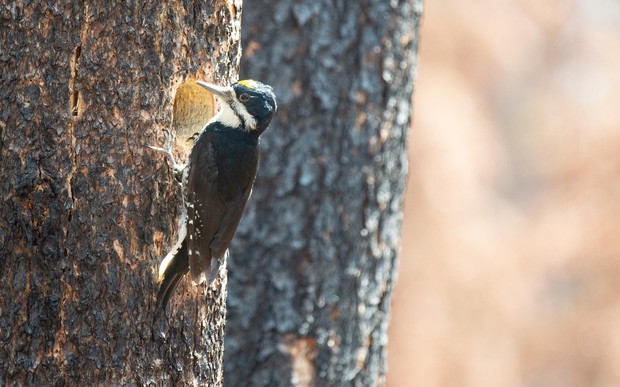
Why Many Northwest Animals And Plants Need Wildfire
Listen
Not all wildfire is a force of destruction. Many of our favorite Northwest plants and animals have evolved to depend on it.
We’ve been taught that thick forests have always blanketed the Northwest — that our natural state is one of verdant green old growth. The idea goes that if we want to protect creatures like the spotted owl, we need to keep forests unchanged at all costs.
But what if that’s wrong?
What if varying levels of regular fire and patchwork forests are the natural state of things — one that native plants and animals need to flourish?
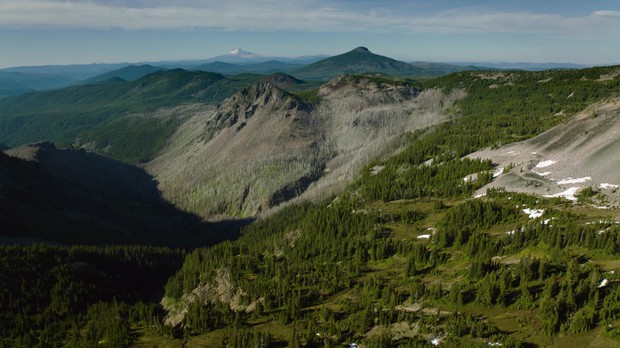
What if a patchy, burned mosaic pattern is the historical state of many Northwest forests? CREDIT: KEVIN FREENY
To help answer those questions, ecologists Paul Hessburg and Bill Gaines volunteer to take us on a tour through a section of the Washington Cascades north of Winthrop that was burned by the Tripod Fire in 2006. The mountainsides are covered in dead snags, burnt black by the fire or bleached grey by the sun, like some undulating, cellulose pincushion. But beneath the dead trees, a new world of shrubs and grasses have covered the ground in rich greens and early fall oranges.
“I’m not seeing a lot of woodpecker activity out here,” Gaines says, scanning the trees as he hikes.
About this story: We want to be transparent about how we reported this. Click here to learn more.
“I haven’t seen a cavity all morning or heard any banging,” Hessburg replies.
The reason we’re looking for woodpeckers is that they’re a poster animal for how scientists like Gaines and Hessburg are reimagining wildfire. Instead of seeing fire as a negative thing that needs to be suppressed, they are finding it is essential to the well-being of many plants and animals.
For example, these burned forests may look barren to us, but for wood-eating insects and their predators, they are a feast waiting to happen.
“One thing we don’t really know is there’s got to be some woodpecker hotline where they’re like, ‘Come on everybody. There’s a lot of food. Let’s get together and eat,’” says Gaines, a research wildlife ecologist with the Washington Conservation Science Institute.
And so, in flock a succession of woodpeckers and other birds. Some, like the black-backed and Lewis’s woodpeckers, are considered fire-dependent because burned trees provide one of the few habitats they can flourish in.
“It is boom and bust for the woodpecker because that abundant food resource is a fairly short-term prospect for them — it’s a 10-year max,” Gaines says.
And they are far from alone. From aspen to morels, from bluebirds to black bears, there’s an incredible range of plants and animals that seek out or thrive best in areas touched by fire.
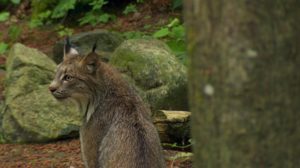
A Canada Lynx at Northwest Trek Wildlife Park. In the wild, these predators prey on snowshoe hares, which, in turn, depend on younger forests that thrive after a wildfire. CREDIT: NICK FISHER
Of Lynx And Lodgepoles
In this Tripod area, we can’t go five feet without running into one of fire’s biggest beneficiaries: the lodgepole pine.
“Check it out right here,” says Hessburg, a research landscape ecologist with the USDA Forest Service Pacific NW Research Station, as he leans over to show off some burnt cone shells on a fallen tree, which is surrounded by small new trees. “These are serotinous cones, which provided the seed for this stand of lodgepole pine here. And so every cone scale is held together by a drop of resin, and it takes the heat of a fire to melt that resin and cause those cone scales to open up, during a fire and just after a fire. So you end up seeing lodgepole regeneration happening really fast.”
The burnt mountainsides here are covered in young lodgepole stands, which are one of the only hunting grounds for one of the country’s most adorable — and threatened — predators: the Canada lynx.
As Gaines walks up to the edge of one of the stands, he turns and says, “OK, so we’re going to pretend we’re a cat; we’re going to pretend we’re a Canada lynx; and what we want to find is our prize food, the snowshoe hare, about 2 to 4 pounds of nutritious meal.”
Gaines crouches down and stalks his way through the thick branches. Stopping beside a random tree, he reaches down to the base below the lowest branches and picks up a small brown pellet. “You can see here a scat from a snowshoe hare, so we know they’ve been here. It tells us this is good habitat for snowshoe hare and good habitat for lynx.”
That’s because these young pines are like a Goldilocks zone. They’re just right: big enough to provide food for bunnies, which eat their bark and needles, but small enough that their branches still go all the way to the ground, providing shelter from the lynx. But as the pines grow taller and their branches no longer touch the ground, the bunnies go in search of new stands, with the lynx following them.
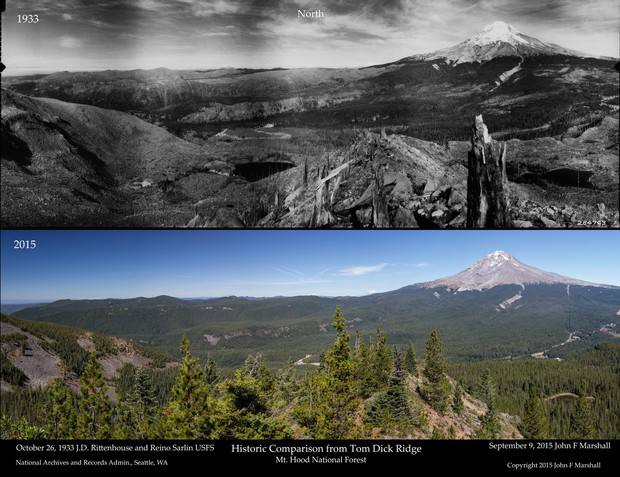
A comparison of the forest density on Mount Hood in 1933 and 2015. CREDIT: USFS/JOHN MARSHALL
As Gaines and Hessburg explain it, few Northwest animals have evolved to live in thick, unchanging forests. Instead, most animals need an evolving, clumpy mosiac of landscapes to meet their needs; like the lynx, which hunts in these post-burn, new forests but rears its kittens in nearby mature forests. And the main driver behind that constant process of change and renewal is fire.
“If you were to roll the film back 100, 150 years in history and take a look at a big landscape panorama, what you would see is places that were burned yesterday, places that were burned five years ago, 10 years ago, that create this variety of habitats,” says Hessburg.
But decades of fire suppression have transformed that landscape in an unbroken blanket of forest.
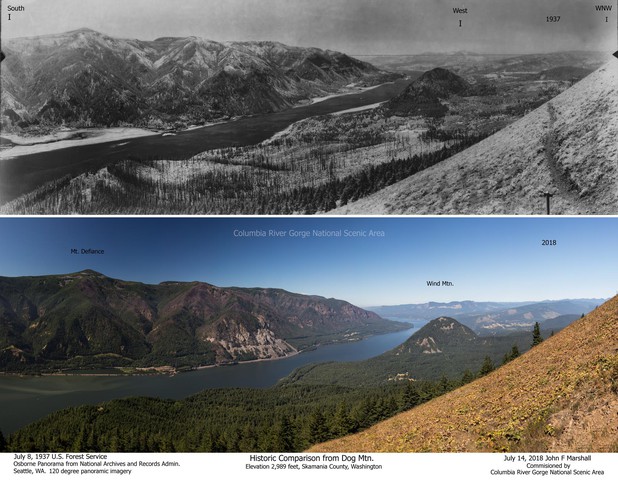
A comparison of the Columbia Gorge forests in 1933 and 2015, as seen from Dog Mountain. USFS/JOHN MARSHALL
“In today’s situation, if you look at these big panoramic landscapes, what you see is an incredibly lower level of diversity, where the forest has all grown up and blended. There are some critters still making a living in that landscape, but it has nowhere near the variety of the former landscape before it was homogenized.”
Today’s thick forests, combined with a warming climate, also set the stage for megafires. The result is two starkly contrasting landscapes and a dynamic far different from the one native animals evolved with. The loss of varied habitat for creatures like the Canada lynx has been devastating. The Washington Department of Fish and Wildlife estimates around 54 cats remain, and that’s the biggest population in the continental U.S.
“Lynx recovery is either made or not here in this part of Washington,” says Gaines.
Of Moose And Meadows
Fire on the landscape gets really interesting when it begins to interact with what we consider fire’s opposite: water.
As we head back to camp, we come across a moose dining on underwater plants in a beaver pond at the bottom of a wetland meadow — one that likely wasn’t nearly as wet before the surrounding forests burned in the Tripod Fire.
“Areas like this meadows area are highly sub-irrigated,” says Hessburg. “So there’s water close to the surface, and the landscape’s being dewatered as the forest grows up.”
Encroaching trees act like giant wooden straws that suck water up the meadows. So regular, patchy fires helps meadows stay wet. Fire also stimulates the growth of shrubs, turning wetland meadows into four-star dining rooms for all manner of creatures, from the tiniest bee to the biggest moose.
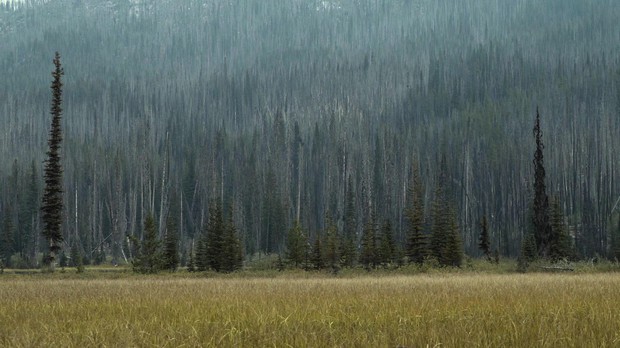
As trees encroach on wetland meadows, they act like giant wooden straws, drying up the meadow as they suck up water. Fire helps keep meadows wet. CREDIT: KEVIN FREENY
“Think about this movable feast where fires are always happening, meadows are going on and offline all the time,” says Hessburg, as the moose trots away from us to the stand of trees beyond, pond plants still dripping from its antlers like a messy to-go meal. “So the moose are moving from place to place with that fire ecology.”
In fact, Gaines says moose had mostly disappeared from this area of Washington in the 20th century due to hunting and the relative lack of meadows from fire suppression, but that’s beginning to change with the recent spate of megafires. “The lack of hunting and the more fire across this landscape restoring those wetlands, they’re interacting, and we’re seeing more moose in more areas across the state of Washington.”
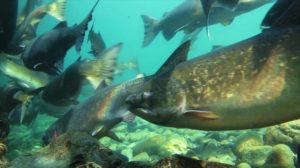
In one of the most surprising relationships, salmon and other fish also benefit from regular fire on the land. CREDIT: WILL HARLING
Of Salmon And Streams
Fire doesn’t just stop these meadow buffets from going dry. Seemingly against all logic, wildfire can make whole river systems flow stronger and cooler.
On a warm July day, Forest Service research ecologist Frank Lake takes us for a drive along the Klamath River and its tributary, the Salmon River, nestled between the Trinity Alps and the Marbled mountains.
Due to a regional inversion, smoke from nearby fires in California and Southern Oregon is hanging like a veil over the valleys. Lake’s newest research shows that this smoke acts like a giant reflector, bouncing back solar radiation to cool the air and the water beneath it.
And during a period of drought and high temperatures, it could not come at a better time for the fish that give the Salmon River its name.
“The salmon particularly are really at stressful levels that are lethal, and the few degrees of cooling from the smoke can be that life or death situation for many of those fish,” says Lake, who works for the Forest Service’s Pacific Southwest Research Station Fire and Fuels Program.
So not only is fire needed by many animals, but smoke can also be a boon. Lake’s research into the dance between fire, smoke and salmon draws from his cultural teachings from the Klamath Basins indigenous tribes: the Karuk and the Yurok.
“When we look at the function of smoke, many times its seen in the media as being detrimental — human health, air quality issues — but from a tribal perspective, smoke is an essential part of the natural process,” he says. “The tribes have a perspective that fire is medicine.”
Like many indigenous Americans, the Karuk and the Yurok developed sophisticated burning practices over the centuries as a form of landscape management to select for certain foods like acorns and berries (both for their own consumption and to draw animals like deer and elk for hunting), to regenerate shrubs for things like basket materials, to control pests and to keep the landscape open around villages, among other reasons.
For the Karuk, in particular, fire was also central to their relationship with salmon.
“Fire plays a lot of roles around the survival of salmon and how that’s ingrained in ceremony,” says Bill Tripp, the deputy director for eco-cultural restoration at the Karuk Department of Natural Resources. “Historically those burns were an annual occurrence.”
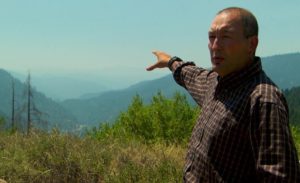
US Forest Service ecologist Frank Lake points out how wildfire smoke hangs in the Klamath and Salmon River valleys, lowering the water temperature for the salmon. CREDIT: NICK FISHER
Tripp says the burns were effectively outlawed beginning in 1911, which led to fire suppression policies across the West.
“We, as Karuk people, believe that those are still our religious freedoms. We still have the ceremonies,” he says. “We just haven’t been able to light the fire that gives our prayer meaning for over a hundred years.”
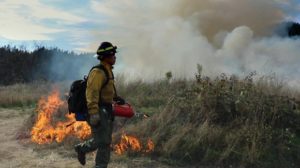
The Karuk Tribe has partnered with other local organizations like the MId Klamath Watershed Council and Klamath River TREX to reintroduce fire to the land with prescribed burns. CREDIT: KLAMATH-SALMON MEDIA COLLABORATIVE
That is, until recently. Now a partnership between the Karuk Tribe, state and federal agencies, and local organizations like the Mid-Klamath Watershed Council and the Salmon River Restoration Council is on the front lines of implementing new policies. They allow prescribed cultural burns. The area has even become a hotbed for teaching prescribed burning techniques to organizations and firefighters from around the country.
In addition to smoke’s cooling effects, fire will also help the salmon by altering the forest.
“Lately I’ve been calling it a ‘Genocide Forest’ because you see most of these fir trees that are in high densities, because even during droughts, Doug firs continue to suck, and they’re big water hogs,” says Chook-Chook Hillman, a natural resource technician with the Karuk Department of Natural Resources. “When you’re keeping fire, you don’t have the densities of Doug fir sucking up the water table.”
Regular fire also sets in motion small landslides, and that debris replenishes salmon habitat over time. Here, again, it’s about the right amount of fire — regular, low-severity fires — as megafires can create massive landslides that are much more problematic, in addition to destroying all the foliage that serves as a shading function for waterways.
“So there are a lot of connections that are just starting to be researched in-depth, but have been well founded in ceremonial practice,” Tripp says of the way that many cutting edge ideas in fire ecology are now serving to validate many tribal practices grounded in traditional ecological knowledge.
No one is advocating we let all fires burn freely — especially the human-caused ones. But a strong consensus is emerging that, as crazy as it sounds, we need to restore regular fire to the land to help our fellow plants and animals survive.
About This Story
Why does this story matter?
So much of the media coverage of fire paints it purely as a force of doom and destruction. But experts have repeatedly told us that fire is a natural process that our forests have evolved with, so we wanted to go in search of the places where fire plays a positive role in the survival and success of many of the plants and animals we love in the Northwest.
What questions did we set out to answer?
Can we understand the complex ways Northwest flora and fauna have evolved to live with and even depend on fire through the stories of several individual species? And then, what are some of the surprising ways fire benefits the survival of these species?
What do we know now?
The interplay between wildfire and ecosystems is infinitely complex. Each ecosystem has a particular fire regime it has evolved with. For instance, wetter forests on the west sides of the Cascades have adapted to low-frequency, high-severity fires, whereas the drier forests on the eastern slopes have evolved with high-frequency, low-severity fires.
Likewise, many plants and animals benefit from a certain level of fire at certain times, but there is definitely too much fire (nothing has evolved with today’s megafires). But what does seem clear is that many of the plants and animals we love most — moose and other large herbivores, lynx and many other carnivores, woodpeckers and an incredible range of birds — do need fires of varying severity over time to flourish.
Who is in this story?
We spoke with more than a dozen ecologists, biologists and other scientists with various universities, tribes and governmental and nongovernmental agencies across the Northwest. Based on that reporting, we selected a group of plants and animals who interact with fire in an often surprising variety of ways, and then chose to focus on scientists who are leading researchers on those creatures. We also wanted to highlight the fire knowledge of many of the region’s indigenous people, who have long understood the ecological value of fire in ways that western science is only now catching up to.
What’s the evidence?
We relied on interviews with the scientists we consulted and numerous peer-reviewed research papers about fire ecology. Here’s one literature review of several studies. Here are specific articles about fire as it relates to lynx (hereand here) and salmon (smoke and habitat creation), and research into how thinning forests can increase water levels.
How can you respond or get involved?
Many organizations are working on prescribed burns. Look for local tribal departments of natural resources, Klamath River TREX, the Nature Conservancy, and others. You can contact us about our coverage at earthfix@opb.org.
Copyright 2018 Earthfix
Related Stories:
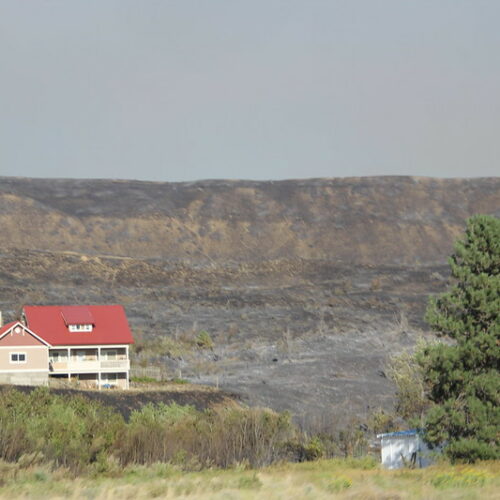
What to do if your insurance company says your home has too much wildfire risk
A home and outbuildings didn’t burn during a fast-moving fire. Some people are worrying more about homeowners policy cancellations in Washington state, as wildfire risk grows. (Credit: Bryan Flint /
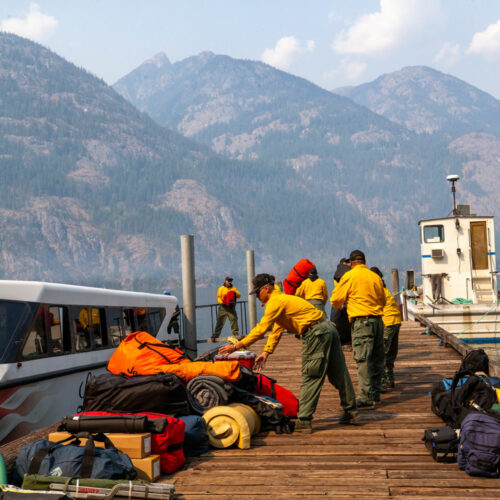
Sixth crew arrives to fight WA’s Pioneer Fire, tiny town still threatened
Crew members unload equipment off of Lady Liberty in Stehekin (Credit: Reneé Dìaz / NWPB) Watch Listen (Runtime 1:07) Read The small, remote town of Stehekin is hard to get
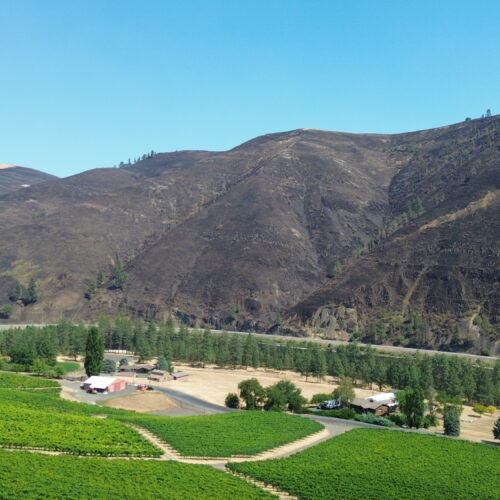
Gwen Fire rages across North Idaho wine country
The Gwen Fire has burned nearly 30,000 acres in the Clearwater Canyon near Juliaetta so far. In this photo taken July 31, 2024, the Rivaura Estate Vineyard and Winery can















